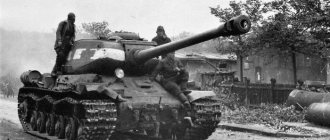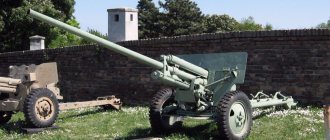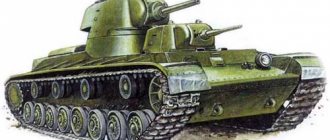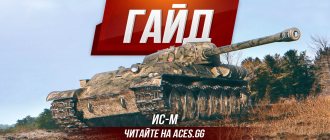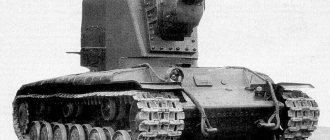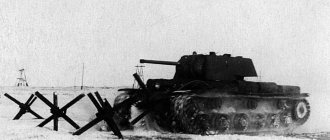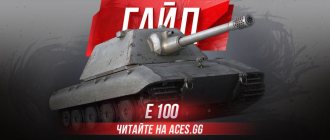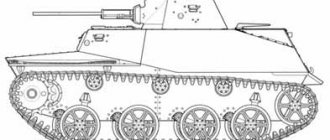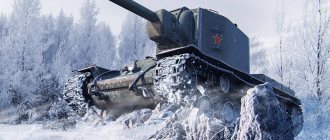During the final period of the Great Patriotic War, the development of heavy tank building took on a new life. At this moment, hard work began on the creation of heavy tanks IS-3, IS-4 and IS-6. This was due to an arms race with the German tank industry, which during the war began to supply the Wehrmacht with armored vehicles with powerful weapons and armor.
At that time, the Red Army included heavy tanks of the KV series, which could not fight on equal terms with enemy armored vehicles. Consequently, a new task arose to create vehicles with impenetrable armor protection and a powerful artillery system. One of these projects was the IS-7 heavy tank, which we will consider in more detail.
History of the IS-7
The history of the IS-7 tank began at the end of 1944, when designers at Plant No. 100 began developing a sketch of a new type of heavy vehicle. This model was supposed to embody all the achievements of Soviet tank building developers accumulated during the war. The project received the support of People's Commissar of Internal Affairs L.P. Beria.
It was thanks to his support that work began on the design of a new machine. The first projects to be created were numbers 257, 258 and 259. The main difference between these samples was the type of transmission (options with electric and mechanical power transmission were installed).
Work on the creation of the next object No. 260 was organized in Leningrad after the end of the war. For a more thorough development of the project, several groups of teams of specialists with extensive practical experience in creating heavy armored vehicles were formed.
Also during the design, the experience gained in the operation and combat use of armored vehicles during the Great Patriotic War was taken into account. The drawings were created very quickly and at the beginning of September 1945 they were approved by the chief designer Zh.Ya. Kotin.
The forehead of the IS-7 hull was made in the shape of a “pike nose”, just like on the IS-3, but with a smaller protrusion forward.
The tank was planned to use a pair of V-16 diesel engines, the total power of which should be 1600 hp. The power transmission is of the electromechanical type (similar to the design used on the IS-6 machine). Thanks to the armor plates located at a large angle, voids were formed where fuel tanks were placed.
The IS-7 turret is cast and flattened. The armament of the project consisted of a 130 mm rifled cannon and 5 machine guns (3 DT machine guns and 2 Vladimirov heavy machine guns of 14.5 mm caliber). The weight of the vehicle reached 65 tons. The life-size object was made only in the form of a wooden model.
Collision model IS-7
Let's first look at how the modules are located inside the tank in order to understand the priority firing locations and actually understand where to penetrate the IS-7.
Forehead:
Left side:
Starboard:
View from above:
Collision model IS-7 rear view:
Project No. 260
The following year, development of a new project began. This object was assigned number 260, the same as the previous one. The designers of the Kirov plant created drawings and assembled two prototypes. The first car, assembled on September 8, 1946, was tested by mileage. The tank covered 1000 km and was able to reach speeds of up to 60 km/h. The results obtained met the stated requirements. The second tank, manufactured on December 25, 1946, had a mileage of 45 km.
To move the IS-7 tank, in accordance with established requirements, it was necessary to mount a diesel engine with a power of at least 1200 hp.
There was no power plant that fully met the declared parameters, and it was decided to mount a paired plant consisting of 2 diesel B-16s produced at plant No. 77. At the same time, the Ministry of Transport and Mechanics sent Plant No. 800 a task to produce an engine with the necessary characteristics.
As a result, Plant No. 800 did not create the engine, and the block of two diesel engines was not ready on time. Further installation of the diesel engine unit and testing by plant No. 100 showed the inconsistency of the idea of installing 2 engines. Engineers from the Kirov Plant, limited in time, turned to Plant No. 500 of the Ministry of Aviation Industry, where it was decided to develop a tank engine based on an aircraft engine branded ACh-300, the power of which was 1,500 hp. The diesel engine project was named TD-30.
The built IS-7 samples were equipped with the new unit. During the tests, the power plant showed good results, but all the results were spoiled by the poor build quality of the engines.
The power transmission of the IS-7 machine was presented in two types. The first is a gearbox (6 gears) with a 2-stage rotation mechanism. The mechanism was controlled using hydraulic servos. The power transmission, during testing, showed good results. The development of the second project of a mechanical transmission (6 gears) with a planetary four-stage rotation mechanism took place jointly with the Moscow Higher Technical School named after. Bauman. Control was also carried out using hydraulic servos.
The design bureau developed several types of suspension, which were mounted and tested on serial armored vehicles and on the first released IS-7. Based on the test results, the final suspension design was formed. The machine has new features such as double-sided shock absorbers, reinforced rollers with internal shock absorption and beam-type torsion bars. The IS-7 moved on tracks 710 mm wide, with cast tracks connected to each other by rubber-metal hinges.
The use of such hinges helped to reduce the noise produced and wear on the track tracks, but the production of these hinges was very difficult and time-consuming.
The IS-7 tank was armed with a 130 mm S-26 gun with a new type of muzzle brake (slotted). The gun was equipped with a loading mechanism that made it possible to increase the rate of fire to 6 rounds per minute. 7 machine guns were mounted on the vehicle. Six had a caliber of 7.62 mm and were operated by an electric drive.
A turret mount, consisting of two 7.62 mm machine guns, was installed in the area of the rear armor plate of the turret. The tests carried out showed the turret's great firing capabilities. It was also planned to install one 14.5 mm machine gun.
To test armor penetration, the Izhora plant additionally produced 2 armored hulls and 2 turrets. After production, they were transported to Kubinka, to the training ground located there, where they were fired from artillery systems of 88 mm, 122 mm and 128 mm caliber. The shelling showed good armor protection of the samples, which contributed to the further approval of the project.
Description of the design of the IS-7 tank
The IS-7 tank had a classic general layout with the control compartment located in the bow of the hull, the fighting compartment in the middle part of the hull and the turret installed on top, and the engine-transmission compartment in the rear of the hull. The tank's crew consisted of five people and was located: the tank commander in the turret to the right of the gun, the driver in the control compartment along the longitudinal axis of the tank, the gunner in the turret to the left of the gun, the loaders in the turret behind the tank commander and gunner.
The tank hull is welded from sheets of rolled homogeneous armor with a frontal part of the “pike nose” type and bent sides. The upper armor plates of the frontal part of the hull with a thickness of 150 mm were inclined at an angle of 680 from the vertical and had a tilt angle of 580. The lower armor plate of the frontal part of the hull with a thickness of 150 mm had an angle of inclination of 500 from the vertical. The side of the tank hull was welded from three armor plates: a top sheet with a thickness of 150 mm, located at an angle of 520 from the vertical, a middle solid-bent sheet with a thickness of 100 mm, and a bottom sheet with a thickness of 16 mm, which had an angle of 630. The roof of the hull, consisting of two armor plates with a thickness of 20 mm.
The solid-cast spherical turret had a variable armor thickness in the frontal part from 210 to 90 mm with wall angles from 00 to 450. The diameter of the turret ring “in the clear” was 2300 mm. In the frontal part of the turret there is an embrasure for installing a cannon and coaxial machine guns, covered with an armored mantlet. In the roof of the turret there were: in the front part of the roof above the seats of the tank commander and gunner - hatches with rotating shoulder straps and sighting and observation devices, in the middle part of the roof - a large rectangular hatch for landing loaders and loading ammunition, in front of this hatch - a turret fan, on aft part of the roof - a bracket with an anti-aircraft machine gun. Armor casings with rearward-oriented, movable machine guns are mounted on the walls of the rear niche of the turret.
The main armament of the tank consisted of one 130-mm S-70 rifled cannon with a small-sized loading mechanism (installed on model No. 4 in 1948), located in the rear niche of the turret, two 14.5-mm KPV-44 machine guns, one of which was coaxial with a cannon (mounted on top of the cannon cradle), the second - anti-aircraft (mounted on a bracket in the rear part of the turret roof), six 7.62-mm RP-46 machine guns (two coaxial with the cannon, two course guns - mounted in armored casings on sides in the middle part of the hull, two aft ones are installed in armored casings on the walls of the aft niche of the turret). The tank's ammunition consisted of 30 rounds of separate-case loading, 400 rounds of 14.5 mm caliber and 2,500 rounds of 7.62 mm caliber.
To stabilize the weapon in the vertical plane, when firing on the move, the tank used a gyroscopic shot control device “Sturm” (attached to the gun cradle) with electromechanical tracking (amplidin) power drives for the vertical guidance of the gun, which ensured automatic aiming of the gun at the target in accordance with a stabilized line of sight and firing a shot with the necessary lead. For aiming when firing from a cannon and coaxial machine guns, a telescopic articulated sight TSh-46V (installed on the Shturm device) and a periscope sight PT-47A with a rangefinder scale were used. To control the tank's fire and adjust it, the tank commander's position was equipped with command control tracking systems in two planes, included in the system of amplidin electric drives for turning the turret and raising the gun. To observe and adjust the fire, the tank commander's seat was equipped with a TPK-2 periscope observation device, with the help of the control handles of which the tank commander could take control of the fire from the cannon and coaxial machine guns, in addition, he could fire from an anti-aircraft machine gun.
The power plant of the tank used a V-shaped four-stroke twelve-cylinder diesel engine M-50T liquid-cooled (ejection system) and a water-driven centrifugal supercharger with a power of 1050 hp. The power transmission of the tank used a single-flow mechanical transmission, which included: a planetary gearbox, a ZK-type turning mechanism, two combined double-row (one row planetary) final drives and a hydraulic servo control system.
The chassis of the tank, in relation to one side, consisted of one gable cast guide wheel located at the front with a crank screw mechanism for tensioning the track, seven gable road wheels with internal shock absorption with a diameter of 730 mm with an individual beam torsion bar suspension, lever-piston hydraulic shock absorbers (inside the balancers of the first, second , sixth and seventh suspension units) and spring travel limiters of the balancers, one rear-mounted drive wheel with replaceable lantern gears and one fine-link caterpillar with a rubber-metal hinge consisting of 93 tracks 700 mm wide.
For external communications, a 10RT radio station was installed on the tank, and for internal communications, a TPU-47 tank intercom. To extinguish the fire in the tank, automatic carbon dioxide fire-fighting equipment with thermal contacts and a light alarm for fire was used. To set up a smoke screen, MDS smoke bombs were used.
Armament
- The 130-mm S-70 gun had a stabilizer to improve shooting accuracy, an electrically driven chain loading mechanism and a muzzle brake with round holes.
- Weight of gun, kg – 4225
- Ammunition, pcs. - thirty
- Initial speed of an armor-piercing projectile, m/s – 900
- Sighting range, m, – 3000
- Vertical aiming angles, degrees: Unknown
Armor penetration
Degrees of inclination are measured in relation to a horizontal surface.
- Armor-piercing, at a distance of 500 m, mm/deg. – 250/90°
- Armor-piercing, at a distance of 2 km, mm/deg. – 210/90°
- Armor-piercing, at a distance of 3 km, mm/deg. – 180/90°
- Rate of fire, rds/min – up to 8
Additional weapons
In total, the IS-7 had 8 machine guns, of which two were 14.5 mm and six were 7.62 mm. One 14.5 machine gun and two 7.62 machine guns were coaxial with the gun and mounted in the gun mantlet, the second 14.5 mm was mounted on the roof of the turret, of the remaining four 7.62 mm machine guns, two were mounted on the sides of the rear of the turret, and two more are on the fenders.
All machine guns of the tank, except those installed in the gun mantlet, were equipped with a remote electric drive. The machine guns' ammunition consisted of 400 14.5 mm rounds and 2,500 7.62 mm rounds.
Heavy and graceful IS-7
The creation of one of the last heavy tanks of the Soviet Union, the IS-7, began back in 1944. In the second half of 1944, the design team under the leadership of Zh.Ya. Kotina set out to summarize all the experience gained during the combat operation of heavy tanks and make a new armored vehicle based on it. True, the authorities did not share this enthusiasm: People’s Commissar of the Tank Industry V.A. Malyshev did not support the idea. However, Kotin was persistent and began to promote the idea through the head of the NKVD L.P. Beria. The People's Commissar of Internal Affairs became interested in the proposal and contributed to the start of work. Moreover, in the winter of 1945, three projects were launched at once, which ultimately led to the creation of the heaviest domestic tank, the IS-7. According to domestic tradition, all new projects bore the name “Object”, but differed in numbers. These were “Object 257”, “258” and “259”. The three different tanks had both advantages and disadvantages.
IS-7 being tested
A prototype of 1948 in the factory yard. This vehicle does not have machine guns in the rear of the turret or an anti-aircraft gun. Photo from the collection of M. Kolomiets
A prototype of 1948 in the factory yard. This vehicle does not have machine guns in the rear of the turret or an anti-aircraft gun. Photo from the collection of M. Kolomiets
After analyzing the created projects and selecting useful solutions, the best developments were collected in “Object 260”, the development of which began in the summer of 1945. An alternative name for the tank was the IS-7 index - this vehicle was intended to continue the line of Joseph Stalin heavy tanks. Taking advantage of the experience of the recently ended war, the designers under the leadership of Kotin were able to complete all engineering work in a matter of months. Already on September 9, a complete package of working drawings was approved. Considerable credit for this belongs to the leading designer N. Shamshurin. In addition to the general coordination of the project, he was one of the initiators of the creation of highly specialized design teams; It was this approach to development that allowed all work to be carried out in a relatively short time. In addition, the division into groups helped to create and introduce into the design of the IS-7 a number of interesting innovations that had not previously been used in Soviet tank building.
The least original was the design of the armored hull. Rolled and cast armor sheets were welded into a single structure. In this case, a number of armor plates were installed at significant angles, up to 60°. Together with frontal and side armor up to 150 millimeters thick, the angles of inclination promised a significant improvement in the level of protection. The frontal part of the tank, as on previous heavy tanks, was made according to the “pike nose” design, however, unlike other armored vehicles, it was slightly smaller in size and did not protrude forward as much. The Object 260 turret was a further development of the corresponding unit of the IS-3 tank. The cast tower had a thickness from 50 millimeters on the roof to 210 in the frontal part. This was accompanied by a 350mm gun mantlet. Inside the reserved volume there was a crew of five people. The workplaces of four of them were located in the fighting compartment and turret.
During the design of the engine-transmission group and chassis, several know-how was also applied, although not always entirely successful. For example, already in the early stages of the project it was proposed to place additional tanks inside the engine compartment. Due to the slope of the side sheets, an unoccupied volume was formed there, in which it was impossible to place any units. In this regard, the free space under the sides and in the engine pedestal was occupied by fuel. However, soon the tanks next to the engine had to be abandoned - even before the construction of the prototype began, it became clear that vibrations from the engine and transmission could destroy the welds of the tanks and lead to fuel leaks. Under certain circumstances, this threatened to cause a fire. It is worth mentioning that it still received an interesting innovation related to the fuel system. The fact is that this was the first domestic tank to use soft fuel tanks. Thanks to the ease of manufacturing a container of complex shape, the efficiency of distribution of internal volumes has increased, and the total amount of diesel fuel has increased from 750 liters of the IS-3 tank to 1300 liters of the IS-7. In addition, the power reserve has almost doubled.
Life-size wooden model of the IS-7 tank. 1946 Photo from the collection of M. Kolomiets
A prototype of 1948 in the factory yard. This vehicle does not have machine guns in the rear of the turret or an anti-aircraft gun. Photo from the collection of G. Petrov
As for the engine and transmission itself, their appearance did not take shape immediately. Initially, during the “260” project, four options for the configuration and layout of the engine-transmission group were considered. KCh-30 diesel engines with a power of 1200 hp were offered as engines. or two B-12s with 600 hp each. every. To interact with each engine, two transmission options were offered. In the first case, these were familiar mechanical mechanisms, in the second, an electrical system. Thus, for the KCh-30 engine a pair of two generators of 323 kW each was intended, and for the V-12 - two of 336 kW each. The two traction electric motors in all variants with electric transmission were the same and had a power equivalent to 315 hp. Regardless of the transmission used, powerful engines required a fairly large volume. It got to the point that there was simply no room left on the bottom of the tank for torsion bars of the required length. To maintain the required suspension characteristics, for the first time in domestic practice, the so-called. beam torsion bars. Instead of one long rod, depreciation was carried out in a package of seven, which had smaller linear dimensions and cross-section. This had a positive effect not only on the smoothness of the ride, but also on the height of the entire armored vehicle. Another original change to the usual schemes was associated with the road wheels. Unlike previous tanks of the design bureau Zh.Ya. Kotin, the IS-7 was equipped with large-sized rollers that did not require the installation of additional support rollers - the upper part of the caterpillar “ran” directly along the support rollers. Of particular note is the original design of the tracks. The cast tracks of the new caterpillar had a rubber-metal joint, thanks to which track wear and noise during movement were significantly reduced. In addition, casting tracks was cheaper than stamping, although in this case additional processing of technological holes was required. And yet, the costs for casting and “per file” were significantly less than before. At the same time, before starting production of tank prototypes, the original idea had to be significantly reworked so that the cheaper technological process would not interfere with the production of serial armored vehicles.
At the beginning of 1946, “Object 260” was significantly improved, but the name of the project remained unchanged, which sometimes causes confusion. The reason for the improvements was a number of identified shortcomings of previously applied solutions, as well as problems with related products. Plant No. 77 could not bring to fruition a pair of two 600-horsepower engines, which is why it was necessary to look for alternative solutions. The situation was similar with a specialized tank diesel engine with 1200 horsepower. Because of such problems, the designers of the Leningrad Kirov Plant urgently had to contact Plant No. 500 and quickly adapt the ACh-300 aviation diesel engine for the tank. Under the name TD-30, this engine was installed on the first prototypes of the IS-7.
Representatives of GBTU and management of the Kirov plant inspect a 1946 prototype. Photo from the collection of P. Lipatov
On September 8, 1946, the first built “Object 260” of the updated project was transferred for testing. By the end of that year, he managed to travel about a thousand kilometers around the training ground. The maximum speed of the 66-ton vehicle on the highway exceeded 60 km/h. On a broken road, the IS-7 accelerated to half the speed. For a heavy tank this was more than good. The original beam torsion bar suspension also earned positive reviews. On December 25, 1946, the second prototype was sent to the test site. A few months later, LKZ workers assembled two armored hulls intended for test firing. The metal of the hull and turret withstood hits from caliber shells of all German anti-tank guns with a caliber of up to 128 millimeters. Tests were also carried out using fire from a 130-mm S-70 gun. The test report stated that the hits had no effect on the condition of the dogs inside the target tanks. And yet there are certain doubts that the crew could have remained calm or even functional after being hit by a 130-mm projectile, even without penetrating the armor.
By the time the first copies of the Object 260 were being assembled, the Central Artillery Design Bureau, together with Perm Plant No. 172, had developed and manufactured a test batch of 130-mm S-26 tank guns. The gun with a removable breech and a slotted muzzle brake provided the 33-kilogram projectile with a speed of 900 meters per second. The tank's stowage chambers accommodated 31 separate-loading shells. A wedge bolt with a semi-automatic copying system, as well as a ramming mechanism, made it possible to increase the gun's rate of fire to 6-8 rounds per minute. However, for a number of reasons, the S-26 gun was soon abandoned. In 1946, at the same TsAKB under the leadership of V.G. The rabe was created for the S-70 tank gun of a similar caliber. In the same year, three prototypes of the gun were assembled, and by 1948, a test batch of fifteen copies was delivered. The S-70 rifled gun had higher performance than the S-26. Thus, a caliber armor-piercing projectile left the barrel at a speed of 1030 m/s, which made it possible to penetrate up to 280 millimeters of homogeneous armor at a distance of a kilometer. The sub-caliber projectile, in turn, had a speed of 1800 m/s and pierced a 350-mm barrier at the same distance. Inside the fighting compartment, rearranged for the S-70, three dozen shells and cartridges were placed.
Starting with the third copy of the IS-7, the S-70 cannon became its main weapon. The tank's additional armament at this stage included a significant number of machine guns: a 14.5 mm KPV and two 7.62 mm RP-46 were installed in the same package with the gun and played the role of coaxial weapons. Another four RP-46 machine guns were placed on the sides of the hull and turret, two on the hull were intended to fire forward, the other two on the turret were intended to fire backwards. Finally, the eighth machine gun (KPV) was placed on the turret and was used as an anti-aircraft gun. Subsequently, on all variants of the Object 260, the quantitative composition of machine guns will not change, although a number of vehicles will be equipped not with RP-46, but with SGMT. At the same time, the design of the machine gun mounts was crude and required a lot of modifications.
Before the production of a trial batch of four cars, the power plant underwent further changes. The TD-30 diesel engine was replaced by the M-50T engine. This marine diesel engine had 12 cylinders and a maximum power of 1050 horsepower. Of course, this was less than the required twin, but there was no choice - the creation of new engines proceeded extremely slowly and without much success. It is noteworthy that when installing the M-50T engine, early developments in beam torsion bars were useful: with their help, it was not necessary to significantly alter the internal volume of the engine-transmission compartment.
During 1948, four new IS-7 tanks with S-70 guns came out of the workshops of the Leningrad Kirov Plant. After short factory tests, they were handed over to testers from the Ministry of Defense. Tester E. Kulchitsky, who was entrusted with starting sea trials of the new tanks, spoke extremely positively about the characteristics of the Object 260. According to him, even at a maximum speed of 60 kilometers per hour, the heavy tank easily obeyed the levers: “the car is absolutely obedient to the driver.” Further runs under the control of drivers E. Kulchitsky, V. Lyashko and K. Kovsh fully confirmed all the reviews, and also helped to collect a number of important information regarding the recommended engine operating modes. Test firing was also generally successful. The problems started a little later.
IS-7. Experienced, manufactured in 1948. Weight - 68 tons, crew - 5 people, length - 7380 mm, width - 3400 mm, height - 2480 mm. Armament - 130-mm cannon (28 rounds of ammunition), 12.7-mm coaxial machine gun, six 7.62-mm machine guns (four installed in front, on tracked shelves and on the sides of the turret, controlled remotely), 12.7- mm anti-aircraft machine gun on the roof of the turret (in the stowed position it folded onto the left side). Reservations - turret front - 210 mm, hull front - 150 mm. Engine power - 1050 hp, speed - 59 km/h, range - 300 km. Rice. Mikhail Petrovsky (Historical series “Technology-Youth” 1990)
For those who like to compare - IS-7 (68 tons, crew - 5 people, height -2600 mm, 130 mm cannon, 28 rounds of ammunition, hull front - 150 mm, turret front - 210 mm) and T-VIB (68 tons, crew - 5 people, height - 3090 mm, 88 mm cannon, ammunition 72 rounds, hull front - 150 mm, turret front - 180 mm) Drawings by M. Petrovsky
First, when fired from an anti-tank gun, the shell ricocheted down from the side and hit the roller mount. It fell off and flew away a fair distance. Obviously, such hits in a combat situation are extremely rare. Yes, only some responsible people began to sarcastically talk about the “colossus with feet of clay.” The next unpleasant incident led to the loss of one of the prototypes. While running around the training ground, the engine caught fire. The automatic fire extinguishing system supplied an extinguishing mixture to the engine compartment twice, but was unable to extinguish the fire. There was no third response (maximum supply - three servings of the mixture). The crew was forced to abandon the tank and watch it burn out. An investigation into the fire revealed that several of the prototype tanks' fuel tanks were made of rubber rather than metal to save weight. For this reason, the containers quickly burned out and literally added “oil” to the fire.
And yet, it seems that these incidents were not the reason for the sad fate of the IS-7 tank. The performance and combat characteristics of the Object 260 were at least no lower than those of foreign armored vehicles of the same class. The latest IS-7 prototypes weighed 68 tons, which the military did not like much. Not every bridge in the Soviet Union could withstand such a load. As a result, the mobility of units armed with heavy tanks greatly deteriorated. The same problem arose with transportation by rail. Weight restrictions on transport infrastructure will subsequently affect the development of all domestic armored vehicles, primarily heavy tanks. It is worth recognizing that foreign tank builders also faced this problem. In the 70s, English and German designers developed the promising MBT-80 tank and found a rather interesting solution to the problems:
Just like when designing the Chieftain. One of the most critical was the problem of mass. The specification of the General Staff limited the mass of the promising tank to 54.8 tons (the mass of the Chieftain Mk.5 tank), however, even during the development of the MVT-80 project, British experts came to the conclusion that it was impossible to enhance armor protection provided that the mass of the new tank was kept at the level mass of "Chieftain" Mk.5. The weight had to be increased to 60-62 tons, in this case it became possible to strengthen the armor of the frontal part of the hull and turret, as well as the sides. MVEE engineers, as a justification for the possibility of increasing mass, put forward the thesis that there is an insignificant difference between 50- and 60-ton tanks. So, with equal specific power and ground pressure, mobility, average speed, throttle response and maneuverability will be approximately the same. One of the criteria limiting the mass of a tank is the load capacity of road bridges. The British carried out an analysis of the distribution of engineering structures in the European theater of operations that limit the mobility of tanks; It turned out that most bridges are designed for a load of 20 tons, that is, they will fail with equal success under both a 50-ton tank and a tank weighing 60 tons, and bridges with a load capacity of 50 and 60 tons are “spread” approximately evenly across Europe. As a result of this kind of research and analysis, it was possible to convince the military to raise the upper weight limit to the required 60-62 tons.
Comparison of IS-7 and German E-100
A number of tank building historians note that from the very beginning the military treated the IS-7 with a certain degree of suspicion, and over time, skepticism only intensified. Perhaps the reason for this was the failure of the IS-4 heavy tank, which had excellent armor, but too much combat weight and, as a result, poor maneuverability. Another interesting explanation for the refusal to adopt the Object 260 concerns changes in views on a future war. In the late forties and early fifties, a view emerged that the major wars of the near future would require the rapid and massive deployment of large numbers of tank units. In addition, nuclear strikes in the first hours of the war could easily destroy up to a third of all armored vehicles. It is obvious that a heavy, poorly transportable and expensive tank, for all its advantages, is not suitable for such conflicts.
Finally, the production of a new heavy tank could seriously affect the pace of construction of established types. The Leningrad and Chelyabinsk plants could not cope with this task without sacrificing anything. Therefore, the Object 260 project was closed. Only one copy of the heaviest domestic tank has survived to this day, which is exhibited in the tank museum of the city of Kubinka.
Based on materials from the sites: https://armor.kiev.ua/ https://pro-tank.ru/ https://vadimvswar.narod.ru/ https://otvaga2004.narod.ru/
Performance characteristics of the IS-7
- Weight, t – 68
- Crew, hours – 5
- Case length, mm – 7380
- Length with gun, mm – 10000
- Case width, mm – 3400
- Height, mm – 2480
- Reservations:
- Body forehead (top), mm/deg. – 150/65°
- Body forehead (bottom), mm/deg. – 150/50°
- Hull side (top), mm/deg. – 150/45°
- Hull side (bottom), mm/deg. – 100/40…65°
- Hull stern (top), mm/deg. – 60/55°
- Hull rear (bottom), mm/deg. – 100/15°
- Bottom, mm – 20
- Housing roof, mm – 20
- Turret front, mm/deg. – 210/51-60°
- Gun mask, mm/deg. – 350/0°
- Tower side, mm/deg. – 150/30-65°
- Tower feed, mm/deg. – 94/0°
- Tower roof, mm – 50
Driving performance:
- Engine power, hp – 1050
- Maximum speed, km/h – 60
- Power reserve, km – 300
- Specific power, hp/t – 15.4
- Climbability, degrees. – 30°
Main modifications of the IS-7 tank
“Object 260” (IS-7 model 1946) is an experimental heavy tank designed by the Design Bureau of the Leningrad branch of Experimental Plant No. 100 and the Department of the Chief Designer of Tank Production LKZ under the leadership of Zh.Ya. Kotin (leading engineer P.P. Isakov) in 1945-1946 based on the projects of heavy tanks “Object 258”, “Object 259”, “Object 260” and “Object 261”. On February 12, 1946, by the Decree of the Council of People's Commissars of the USSR, the tank was given the open designation IS-7, which was based on the Object 260 tank project. In total, two experimental Object 260 tanks and two sets of hulls and turrets for shelling tests were manufactured at LKZ, which later received the designation IS-7 model 1946 (the first on September 8, the second on December 25, 1946). During 1946, both tanks underwent intensive factory testing. On August 1, 1947, tank testing was completed, concentrating efforts on finalizing the design of an improved version of the IS-7 tank.
The Object 260 tank differed from the IS-7 model 1947 tank:
- The design of the armored hull, which had a smaller width, a composite side made of rolled armor plates (top thickness 150 mm, middle thickness - 100 mm, bottom thickness - 16 mm), a different layout of the engine-transmission compartment due to the use of a different engine and power transmission, a different engine roof -transmission compartment, due to the use of a fan cooling system for the power plant.
- The shape of a cast turret (the armor thickness of the frontal part is 240 mm) with a clearly defined aft niche and a different frontal part (during shelling tests it was considered unsuccessful and had to be replaced). The diameter of the turret ring “in the clear” was 2000 mm. On the welded roof of the turret, 30 mm thick, there were located: in the front part on the right - a commander's cupola with three viewing devices and a hatch, on the left - the gunner's sight head, in the middle part of the turret, a turret fan cap was mounted in the middle, behind it on the right was a rectangular double-leaf hatch for the first loader, on the left – a hatch for landing the gunner and the second loader with a rotating shoulder strap, on which an anti-aircraft machine gun mount was installed; a machine gun turret with coaxial machine guns was located in the rear wall of the aft turret.
- The main armament of the tank consisted of one 130-mm rifled S-26 cannon with an automatic loader in the rear niche of the turret, one 14.5-mm KPV-44 machine gun (on an anti-aircraft machine gun mount), seven 7.62-mm ShKAS machine guns (one paired with the cannon, two in armored boxes on the gun mantlet, two in armored boxes on the fenders for firing to the rear, two in a remote-controlled turret at the rear of the turret). The tank's ammunition load was 30 rounds of separate-case loading for the gun, 300 rounds of 14.5 mm caliber and 2000 rounds of 7.62 mm caliber.
- The power plant used a four-stroke V-shaped twelve-cylinder diesel engine TD-30 liquid cooled (fan system) with a centrifugal supercharger with a power of 1200 hp.
- The tank's mechanical single-flow power transmission consisted of a multi-disc main clutch, a three-shaft six-speed gearbox with shift cages and synchronizers, two two-stage planetary turning mechanisms, two planetary final drives, and a hydraulic servo control system.
- The chassis of the tank used a two-shaft tubular-rod suspension and support rollers with a diameter of 703 mm, unlike the IS-7.
- For internal communication, a TPU-4-Bis tank intercom was installed in the tank.
For the Object 260 tank, infrared sighting and observation devices were developed based on German developments, but their creation was delayed until the early 1950s.
IS-7 arr. 1947 - an experimental heavy tank designed by the LKZ Design Bureau (January 1, 1947, the Department of the Chief Designer of Tank Production LKZ and the Design Bureau of the Leningrad Branch of Experimental Plant No. 100 merged) under the leadership of Zh.Ya. Kotin in 1947-1948 based on the design of the IS-7 tank mod. 1946. The first model of the tank was released at LKZ on August 24, 1947, the second on October 6, the third on December 30, the fourth on July 11, 1948. After the decision was made to stop development work on the IS-7 tank, experimental tanks continued to be used for testing components and assemblies of promising heavy tanks until the early 1950s.
How to play the IS-7
We started the review with a comparison of the two top heavyweights of the Soviet development branch. So, the IS-7 is a breakthrough tank that can rush a direction, confidently repelling random hits with its armor. The IS-4 is a defense vehicle capable of confidently defending any city street or exposing its sides to enemy attacks and holding back the onslaught near its base. Speaking of the IS-7, the main task of the tank is to systematically push out the enemy in the chosen direction. At the same time, the vehicle can also protect any of the flanks abandoned by its teammates.
So, taking advantage of the impressive parameters of the given armor, the “seven” needs to hide the NLD and take any hits with the turret. It is worth noting that the frontal armor holds up well the shells fired by a level 10 tank destroyer, so purely theoretically, the IS-7, if properly positioned, is quite capable of holding off an enemy attack on its own. If it is not possible to completely hide the NLD, we use any cover to attack the enemy, turning our cheeks. Here the armor plates are located at good angles, which gives a high chance of ricochet. Thus, you can peek around the corners of buildings and destroyed equipment. The enemy sees only part of the tower and hull, which prevents him from causing damage. Although rare hits can still penetrate the lower armor plate, there is no escape from this: it is impossible to completely hide the tank on open maps. It is important to understand that it is better not to be alone. Not a single tank in the game can withstand several enemies who are attacking en masse, so ideally, the IS-7 should be covered by 1-2 teammates who will not allow the tank to be bypassed from the sides. Remember that the “ seven ” has good dynamics, so it has time to occupy advantageous positions, change directions of attack, or return to defend its base. When meeting fast-firing opponents in a random environment, it is better to clinch with them. This way we neutralize the advantage of the enemy’s weapon and do not allow him to leave the confrontation. When going at point-blank range, you need to constantly aim your sights at the enemy’s gun, preventing him from targeting vulnerable areas. The mechanics of the game are designed in such a way that a shot into the barrel with an armor-piercing projectile does not cause damage, but a high-explosive charge becomes dangerous for the shooter. In a clinch, you shouldn’t “dance” with your opponent, turning your vulnerable cheeks. The IS-7 may well look at the enemy head-on, catching unpenetrated targets and inflicting damage.
The further fate of the project
By mid-1948, the Kirov Plant produced 4 more IS-7 samples. After factory tests, these vehicles were sent to government production. The commission members were completely satisfied with the results of the state tests.
Weighing 68 tons, the vehicle easily picked up speed up to 60 km/h, and the protection did not allow shells from 128 and 130 mm tank guns to penetrate it.
But not all tests of the IS-7 tank went smoothly. During the shelling, the shell ricocheted off the side and hit the chassis, tearing out the support roller along with part of the suspension from the armor plate. During mileage testing of one of the cars, the engine, whose warranty mileage had expired, caught fire. The fire extinguishing system, after 2 attempts, was unable to localize the fire and the tank burned out completely.
The government tests of the IS-7 showed good results, and in 1949 a government order was received for the Kirov Plant to produce 50 units. But soon a decree was issued to curtail work on armored vehicles, the weight of which exceeded 50 tons. At an accelerated pace, the work was curtailed, and not one of the ordered IS-7s was ever produced.
Equipment on the IS-7
Additional equipment includes a rammer and aiming stabilizer. The last slot is filled variably, but it is better to opt for improved ventilation in order to comprehensively improve all characteristics. There is no choice for combat consumables, so we load an automatic fire extinguisher, a large repair kit and a first aid kit. This set of equipment will significantly increase the vehicle’s chance of survival. If there are problems with silver, premium consumables can be replaced with basic ones.
